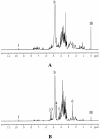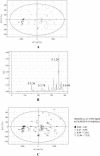Metabolic discrimination of Catharanthus roseus leaves infected by phytoplasma using 1H-NMR spectroscopy and multivariate data analysis
- PMID: 15286294
- PMCID: PMC520807
- DOI: 10.1104/pp.104.041012
Metabolic discrimination of Catharanthus roseus leaves infected by phytoplasma using 1H-NMR spectroscopy and multivariate data analysis
Abstract
A comprehensive metabolomic profiling of Catharanthus roseus L. G. Don infected by 10 types of phytoplasmas was carried out using one-dimensional and two-dimensional NMR spectroscopy followed by principal component analysis (PCA), an unsupervised clustering method requiring no knowledge of the data set and used to reduce the dimensionality of multivariate data while preserving most of the variance within it. With a combination of these techniques, we were able to identify those metabolites that were present in different levels in phytoplasma-infected C. roseus leaves than in healthy ones. The infection by phytoplasma in C. roseus leaves causes an increase of metabolites related to the biosynthetic pathways of phenylpropanoids or terpenoid indole alkaloids: chlorogenic acid, loganic acid, secologanin, and vindoline. Furthermore, higher abundance of Glc, Glu, polyphenols, succinic acid, and Suc were detected in the phytoplasma-infected leaves. The PCA of the (1)H-NMR signals of healthy and phytoplasma-infected C. roseus leaves shows that these metabolites are major discriminating factors to characterize the phytoplasma-infected C. roseus leaves from healthy ones. Based on the NMR and PCA analysis, it might be suggested that the biosynthetic pathway of terpenoid indole alkaloids, together with that of phenylpropanoids, is stimulated by the infection of phytoplasma.
Figures











References
-
- Agrawal PK (1992) NMR spectroscopy in the structural elucidation of oligosaccharides and glycosides. Phytochemistry 31: 3307–3330 - PubMed
-
- Bailey NJ, Oven M, Holmes E, Nicholson JK, Zenk MH (2003) Metabolomic analysis of the consequences of cadmium exposure in Silene cucubalus cell cultures via 1H-NMR spectroscopy and chemometrics. Phytochemistry 62: 851–858 - PubMed
-
- Batjer LP, Schneider H (1960) Relation of pear decline to rootstocks and sieve-tube necrosis. Proc Am Soc Hortic Sci 76: 85–97
-
- Catlin PB, Olsson EA, Beutel JA (1975) Reduced translocation of carbon and nitrogen from leaves with symptoms of pear curl. J Am Soc Hortic Sci 100: 184–187
-
- Dixon RA (2001) Natural products and disease resistance. Nature 411: 843–847 - PubMed
Publication types
MeSH terms
LinkOut - more resources
Full Text Sources

